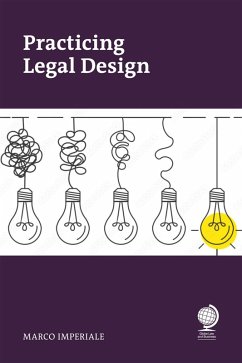Marco Imperiale
Practicing Legal Design (eBook, ePUB)
175,95 €
175,95 €
inkl. MwSt.
Sofort per Download lieferbar

88 °P sammeln
175,95 €
Als Download kaufen

175,95 €
inkl. MwSt.
Sofort per Download lieferbar

88 °P sammeln
Jetzt verschenken
Alle Infos zum eBook verschenken
175,95 €
inkl. MwSt.
Sofort per Download lieferbar
Alle Infos zum eBook verschenken

88 °P sammeln
Marco Imperiale
Practicing Legal Design (eBook, ePUB)
- Format: ePub
- Merkliste
- Auf die Merkliste
- Bewerten Bewerten
- Teilen
- Produkt teilen
- Produkterinnerung
- Produkterinnerung

Bitte loggen Sie sich zunächst in Ihr Kundenkonto ein oder registrieren Sie sich bei
bücher.de, um das eBook-Abo tolino select nutzen zu können.
Hier können Sie sich einloggen
Hier können Sie sich einloggen
Sie sind bereits eingeloggt. Klicken Sie auf 2. tolino select Abo, um fortzufahren.

Bitte loggen Sie sich zunächst in Ihr Kundenkonto ein oder registrieren Sie sich bei bücher.de, um das eBook-Abo tolino select nutzen zu können.
Legal design is no longer a niche concept but a growing movement reshaping how legal services are delivered, understood, and experienced. While discussions around innovation in law have gained momentum, meaningful adoption often lags behind ambition. Many legal professionals recognize the need for transformation but struggle to integrate a prototype-driven and interdisciplinary approach into their working environments. This book bridges the gap between theory and execution, offering a comprehensive guide to implementing legal design in law firms, legal departments, institutions, and other…mehr
- Geräte: eReader
- ohne Kopierschutz
- eBook Hilfe
- Größe: 0.95MB
Andere Kunden interessierten sich auch für
![Legal Operations in the Age of AI and Data (eBook, ePUB) Legal Operations in the Age of AI and Data (eBook, ePUB)]() Legal Operations in the Age of AI and Data (eBook, ePUB)175,95 €
Legal Operations in the Age of AI and Data (eBook, ePUB)175,95 €![Product Counsel (eBook, ePUB) Product Counsel (eBook, ePUB)]() Olga MackProduct Counsel (eBook, ePUB)175,95 €
Olga MackProduct Counsel (eBook, ePUB)175,95 €![Tipping Point (eBook, ePUB) Tipping Point (eBook, ePUB)]() Merry NeitlichTipping Point (eBook, ePUB)175,95 €
Merry NeitlichTipping Point (eBook, ePUB)175,95 €![Managing Legal Change Initiatives (eBook, ePUB) Managing Legal Change Initiatives (eBook, ePUB)]() Patrick J MckennaManaging Legal Change Initiatives (eBook, ePUB)175,95 €
Patrick J MckennaManaging Legal Change Initiatives (eBook, ePUB)175,95 €![Innovations in Legal KM (eBook, ePUB) Innovations in Legal KM (eBook, ePUB)]() Oz BenamramInnovations in Legal KM (eBook, ePUB)175,95 €
Oz BenamramInnovations in Legal KM (eBook, ePUB)175,95 €![The Handbook for Legal Innovation (eBook, ePUB) The Handbook for Legal Innovation (eBook, ePUB)]() Nicola ShaverThe Handbook for Legal Innovation (eBook, ePUB)69,95 €
Nicola ShaverThe Handbook for Legal Innovation (eBook, ePUB)69,95 €![Practical Innovations in Legal Pricing (eBook, ePUB) Practical Innovations in Legal Pricing (eBook, ePUB)]() Timothy B CorcoranPractical Innovations in Legal Pricing (eBook, ePUB)289,95 €
Timothy B CorcoranPractical Innovations in Legal Pricing (eBook, ePUB)289,95 €-
-
-
Legal design is no longer a niche concept but a growing movement reshaping how legal services are delivered, understood, and experienced. While discussions around innovation in law have gained momentum, meaningful adoption often lags behind ambition. Many legal professionals recognize the need for transformation but struggle to integrate a prototype-driven and interdisciplinary approach into their working environments. This book bridges the gap between theory and execution, offering a comprehensive guide to implementing legal design in law firms, legal departments, institutions, and other legal service environments. From exploring user-centered approaches to structuring design-driven processes, it provides actionable insights into how legal design can enhance clarity, accessibility, and efficiency in legal services. Drawing on extensive experience in legal design, innovation, and transformation, this book blends strategic vision with hands-on experience. It goes beyond high-level discussions to address the real-world challenges of integrating legal design thinking into legal practice, whether that means overcoming organizational resistance, aligning stakeholders, or proving the value of legal design to decision makers. It also offers practical tools and frameworks to navigate the hidden complexities of legal design projects, ensuring that design-driven change is not only embraced but sustained. Whether you're just starting your journey in legal design or already working on innovation projects, this book serves as a practical resource that you can revisit as challenges and opportunities arise. By blending theory with real-world application, it provides a roadmap for making legal design a fundamental and effective part of legal practice.
Dieser Download kann aus rechtlichen Gründen nur mit Rechnungsadresse in A, D ausgeliefert werden.
Produktdetails
- Produktdetails
- Verlag: Globe Law and Business
- Seitenzahl: 282
- Erscheinungstermin: 19. August 2025
- Englisch
- ISBN-13: 9781837231201
- Artikelnr.: 74203628
- Verlag: Globe Law and Business
- Seitenzahl: 282
- Erscheinungstermin: 19. August 2025
- Englisch
- ISBN-13: 9781837231201
- Artikelnr.: 74203628
- Herstellerkennzeichnung Die Herstellerinformationen sind derzeit nicht verfügbar.
Contents
Acknowledgments
About the author
Preface
Heidi Gardner
Introduction: Why (A)nother legal design book?
Part I. Ontology
Introduction to Part I: Opening the Door
Chapter 1: So this is legal design
Law and the Oral B toothbrush
A definition (or many definitions?)
What legal design is not
A panacea for all evil. Well, no…
A global movement
Prototyping in the legal world
The legal designer. A new job?
When law firms offer legal design services
Chapter 2: Principles of legal design
Why do we need to speak about principles?
Principle 1: Human-centrism
Principle 2: Co-creation
Principle 3: Diversity and inclusion
Principle 4: A non-hierarchical approach
Principle 5: Process first
Principle 6: Divergence and convergence
Principle 7: Fail fast
Principle 8: How might we?
Principle 9: Productification
Principle 10: KISS (Keep It Simple, Stupid!)
Principle 11: Dignity
Principle 12: + 1
Future principles
Chapter 3: The why of legal design
New context, new demand
A form of innovation – or innovations
The legal experience
The illusion of reading (legal) texts
F-patterns and scanning – how we actually read
A neurological case for legal design
A nudging law
Is legal design just for B2C?
Chapter 4: Abandoning the legalese – communicating plain
A quick introduction to plain language
What does it mean to communicate clearly?
Benefits of clarity and comprehension
The plain language ISO
A world in emojis
Notes about inclusive language
The intercultural factor
Thoughtful perspective: Michael Doherty
Part II. Legal Design and…
Introduction to Part II: Beyond Legal Design
Chapter 5: Legal design and other designs
Legal design vs…
Legal design or contract design?
Chapter 6: Legal design and sustainability
Legal design and the United Nations 2030 Agenda
Enhancing accessibility
About clear communication as human right
Legal design and neurodiversity, part one – designing
for a neurodiverse audience
Legal design and neurodiversity part two – when the
legal designer is neurodivergent
Redesigning governance towards transparency
Chapter 7: Legal design and artificial intelligence
The evolution of legal design with generative AI
From design thinking to emerging thinking
How about AI as final user?
Thinking before building
Ethical considerations and challenges
Chapter 8: Legal design and dark patterns
What is a dark pattern?
Dark patterns in practice
Why legal design is important for dark patterns
(and potential related risks)
Chapter 9: Legal design and proactive law
What is proactive law? Evolutions and significance
Benefits of proactive law
Five main barriers to proactive law and potential
pathways to success
Legal design and proactive law
Chapter 10: Legal design and gamification
A quick intro to gamification
Gamification in the legal field – strategies and applications
Challenges and ethical considerations of gamification
in the legal field
A virtual legal experience
Legal design and gamification
Thoughtful perspective: Ashleigh Ruggles and Maclen Stanley
Part III. From Theory to Practice
Introduction to Part III: Law and the Ikea Instructions
Chapter 11: Setting the stage for our legal design project
Choosing the format, part one – online, in person, or hybrid?
Choosing the format, part two – hackathons, jams,
and periodic sessions
Choosing the format, part three – parallel, serial, or both?
Preparing a legal design project
Involving the right players and creating an inclusive environment
Developing a preliminary checklist
Creating common knowledge
Chapter 12: The legal design toolbox
The platforms
Most common visual tools
Icons
Patterns libraries
Tools for law firms
Readability tests and software
An always evolving scenario
Chapter 13: 12 challenges of a legal design project (and tips to overcome
them)
Challenge 1: Is this thing valid?
Challenge 2: Budget
Challenge 3: Internal selling
Challenge 4: Managing time constraints
Challenge 5: Quantifying benefits – measuring what’s often hidden
Challenge 6: Avoid deviating from the original project
Challenge 7: The Tetris agenda – balancing competing priorities
Challenge 8: Navigating interdisciplinary teamwork
Challenge 9: Establishing a structured framework
Challenge 10: Different clients, different organizations, different
processes – adapting to varied needs
Challenge 11: The smartest ones in the room
Challenge 12: Modification and editability of legal design outputs
Chapter 14: 12 tips for great legal design sessions
Tip 1: Don’t let equity partners and general counsels run the show
Tip 2: Manage interruptions wisely
Tip 3: Be cautious with recording sessions
Tip 4: Use of AI tools for minutes
Tip 5: Assign homework duties
Tip 6: Adopt forward, not backward thinking
Tip 7: Rely on evangelists
Tip 8: Maintain an informal approach
Tip 9: Less words, more practice
Tip 10: Celebrate small wins
Tip 11: Manage cognitive load
Tip 12: Defer judgment
Chapter 15: The 12 most common mistakes in legal design (AKA the best
lessons I’ve learned)
Mistake 1: Thinking you know the user
Mistake 2: Considering the contract out of its system
Mistake 3: Raising excessive expectations
Mistake 4: Expecting legal design to fix everything
Mistake 5: Losing the initial enthusiasm
Mistake 6: Treating documents as static artefacts
Mistake 7: Assuming our documents are already good enough
Mistake 8: Jumping directly to the solutions
Mistake 9: Lack of interdisciplinary collaboration
Mistake 10: Downplaying resistance to change within legal teams
Mistake 11: Underestimating regulatory and ethical considerations
Mistake 12: Treating legal design as a one-time effort
Chapter 16: Practical applications of AI for legal design projects
Choosing the right engine – a short guide to AI tools
Building with the machine – prototyping in practice
From drafting to conversating – specific uses of AI
More tools, better questions
Chapter 17: Leveraging on the learning experience
Gathering feedback and listening for learning
Maintaining momentum
After the project is done – turning (more) ideas into action
Thoughtful perspective: Sally Guyer
Part IV. The Leonardo Framework
Introduction to Part IV: Towards a Common Ground
Chapter 18: The Leonardo framework
A bunch of disclaimers
How about three levels of legal design?
Level 1: The base of the pyramid
Level 2: The magic of legal design thinking
Level 3: Metricizing the law
Chapter 19: Level 1 of the Leonardo framework
Preamble – always users first
Step 1: Look. Read. Listen
Step 2: Clarifying the language, part one – things to avoid
Step 3: Clarifying the language, part two – things to do
Step 4: A matter of how
Step 5: Refining our typography
Thinking in terms of information architecture
Chapter 20: Level two of the Leonardo Framework
From level one to level two – from intervention to intention
Step 1: What do we want to achieve? What impact do we want
to have?
Step 2: Empathize
Step 3: Define
Step 4: Ideate
Step 5: Prototype
Step 6: Test
Step 7: Refining our work
Chapter 21: Level three of the Leonardo framework
From level two to level three
Why we need to measure impact
Working towards an impact analysis
Reflections about scalability
Delving into A/B testing
The measure of maturity
Three levels and Dante’s Paradise
Thoughtful perspective: M. Butterick
Chapter 22: Conclusion – legal design and the Ikigai a pathway to holistic
fulfilment
Acknowledgments
About the author
Preface
Heidi Gardner
Introduction: Why (A)nother legal design book?
Part I. Ontology
Introduction to Part I: Opening the Door
Chapter 1: So this is legal design
Law and the Oral B toothbrush
A definition (or many definitions?)
What legal design is not
A panacea for all evil. Well, no…
A global movement
Prototyping in the legal world
The legal designer. A new job?
When law firms offer legal design services
Chapter 2: Principles of legal design
Why do we need to speak about principles?
Principle 1: Human-centrism
Principle 2: Co-creation
Principle 3: Diversity and inclusion
Principle 4: A non-hierarchical approach
Principle 5: Process first
Principle 6: Divergence and convergence
Principle 7: Fail fast
Principle 8: How might we?
Principle 9: Productification
Principle 10: KISS (Keep It Simple, Stupid!)
Principle 11: Dignity
Principle 12: + 1
Future principles
Chapter 3: The why of legal design
New context, new demand
A form of innovation – or innovations
The legal experience
The illusion of reading (legal) texts
F-patterns and scanning – how we actually read
A neurological case for legal design
A nudging law
Is legal design just for B2C?
Chapter 4: Abandoning the legalese – communicating plain
A quick introduction to plain language
What does it mean to communicate clearly?
Benefits of clarity and comprehension
The plain language ISO
A world in emojis
Notes about inclusive language
The intercultural factor
Thoughtful perspective: Michael Doherty
Part II. Legal Design and…
Introduction to Part II: Beyond Legal Design
Chapter 5: Legal design and other designs
Legal design vs…
Legal design or contract design?
Chapter 6: Legal design and sustainability
Legal design and the United Nations 2030 Agenda
Enhancing accessibility
About clear communication as human right
Legal design and neurodiversity, part one – designing
for a neurodiverse audience
Legal design and neurodiversity part two – when the
legal designer is neurodivergent
Redesigning governance towards transparency
Chapter 7: Legal design and artificial intelligence
The evolution of legal design with generative AI
From design thinking to emerging thinking
How about AI as final user?
Thinking before building
Ethical considerations and challenges
Chapter 8: Legal design and dark patterns
What is a dark pattern?
Dark patterns in practice
Why legal design is important for dark patterns
(and potential related risks)
Chapter 9: Legal design and proactive law
What is proactive law? Evolutions and significance
Benefits of proactive law
Five main barriers to proactive law and potential
pathways to success
Legal design and proactive law
Chapter 10: Legal design and gamification
A quick intro to gamification
Gamification in the legal field – strategies and applications
Challenges and ethical considerations of gamification
in the legal field
A virtual legal experience
Legal design and gamification
Thoughtful perspective: Ashleigh Ruggles and Maclen Stanley
Part III. From Theory to Practice
Introduction to Part III: Law and the Ikea Instructions
Chapter 11: Setting the stage for our legal design project
Choosing the format, part one – online, in person, or hybrid?
Choosing the format, part two – hackathons, jams,
and periodic sessions
Choosing the format, part three – parallel, serial, or both?
Preparing a legal design project
Involving the right players and creating an inclusive environment
Developing a preliminary checklist
Creating common knowledge
Chapter 12: The legal design toolbox
The platforms
Most common visual tools
Icons
Patterns libraries
Tools for law firms
Readability tests and software
An always evolving scenario
Chapter 13: 12 challenges of a legal design project (and tips to overcome
them)
Challenge 1: Is this thing valid?
Challenge 2: Budget
Challenge 3: Internal selling
Challenge 4: Managing time constraints
Challenge 5: Quantifying benefits – measuring what’s often hidden
Challenge 6: Avoid deviating from the original project
Challenge 7: The Tetris agenda – balancing competing priorities
Challenge 8: Navigating interdisciplinary teamwork
Challenge 9: Establishing a structured framework
Challenge 10: Different clients, different organizations, different
processes – adapting to varied needs
Challenge 11: The smartest ones in the room
Challenge 12: Modification and editability of legal design outputs
Chapter 14: 12 tips for great legal design sessions
Tip 1: Don’t let equity partners and general counsels run the show
Tip 2: Manage interruptions wisely
Tip 3: Be cautious with recording sessions
Tip 4: Use of AI tools for minutes
Tip 5: Assign homework duties
Tip 6: Adopt forward, not backward thinking
Tip 7: Rely on evangelists
Tip 8: Maintain an informal approach
Tip 9: Less words, more practice
Tip 10: Celebrate small wins
Tip 11: Manage cognitive load
Tip 12: Defer judgment
Chapter 15: The 12 most common mistakes in legal design (AKA the best
lessons I’ve learned)
Mistake 1: Thinking you know the user
Mistake 2: Considering the contract out of its system
Mistake 3: Raising excessive expectations
Mistake 4: Expecting legal design to fix everything
Mistake 5: Losing the initial enthusiasm
Mistake 6: Treating documents as static artefacts
Mistake 7: Assuming our documents are already good enough
Mistake 8: Jumping directly to the solutions
Mistake 9: Lack of interdisciplinary collaboration
Mistake 10: Downplaying resistance to change within legal teams
Mistake 11: Underestimating regulatory and ethical considerations
Mistake 12: Treating legal design as a one-time effort
Chapter 16: Practical applications of AI for legal design projects
Choosing the right engine – a short guide to AI tools
Building with the machine – prototyping in practice
From drafting to conversating – specific uses of AI
More tools, better questions
Chapter 17: Leveraging on the learning experience
Gathering feedback and listening for learning
Maintaining momentum
After the project is done – turning (more) ideas into action
Thoughtful perspective: Sally Guyer
Part IV. The Leonardo Framework
Introduction to Part IV: Towards a Common Ground
Chapter 18: The Leonardo framework
A bunch of disclaimers
How about three levels of legal design?
Level 1: The base of the pyramid
Level 2: The magic of legal design thinking
Level 3: Metricizing the law
Chapter 19: Level 1 of the Leonardo framework
Preamble – always users first
Step 1: Look. Read. Listen
Step 2: Clarifying the language, part one – things to avoid
Step 3: Clarifying the language, part two – things to do
Step 4: A matter of how
Step 5: Refining our typography
Thinking in terms of information architecture
Chapter 20: Level two of the Leonardo Framework
From level one to level two – from intervention to intention
Step 1: What do we want to achieve? What impact do we want
to have?
Step 2: Empathize
Step 3: Define
Step 4: Ideate
Step 5: Prototype
Step 6: Test
Step 7: Refining our work
Chapter 21: Level three of the Leonardo framework
From level two to level three
Why we need to measure impact
Working towards an impact analysis
Reflections about scalability
Delving into A/B testing
The measure of maturity
Three levels and Dante’s Paradise
Thoughtful perspective: M. Butterick
Chapter 22: Conclusion – legal design and the Ikigai a pathway to holistic
fulfilment
Contents
Acknowledgments
About the author
Preface
Heidi Gardner
Introduction: Why (A)nother legal design book?
Part I. Ontology
Introduction to Part I: Opening the Door
Chapter 1: So this is legal design
Law and the Oral B toothbrush
A definition (or many definitions?)
What legal design is not
A panacea for all evil. Well, no…
A global movement
Prototyping in the legal world
The legal designer. A new job?
When law firms offer legal design services
Chapter 2: Principles of legal design
Why do we need to speak about principles?
Principle 1: Human-centrism
Principle 2: Co-creation
Principle 3: Diversity and inclusion
Principle 4: A non-hierarchical approach
Principle 5: Process first
Principle 6: Divergence and convergence
Principle 7: Fail fast
Principle 8: How might we?
Principle 9: Productification
Principle 10: KISS (Keep It Simple, Stupid!)
Principle 11: Dignity
Principle 12: + 1
Future principles
Chapter 3: The why of legal design
New context, new demand
A form of innovation – or innovations
The legal experience
The illusion of reading (legal) texts
F-patterns and scanning – how we actually read
A neurological case for legal design
A nudging law
Is legal design just for B2C?
Chapter 4: Abandoning the legalese – communicating plain
A quick introduction to plain language
What does it mean to communicate clearly?
Benefits of clarity and comprehension
The plain language ISO
A world in emojis
Notes about inclusive language
The intercultural factor
Thoughtful perspective: Michael Doherty
Part II. Legal Design and…
Introduction to Part II: Beyond Legal Design
Chapter 5: Legal design and other designs
Legal design vs…
Legal design or contract design?
Chapter 6: Legal design and sustainability
Legal design and the United Nations 2030 Agenda
Enhancing accessibility
About clear communication as human right
Legal design and neurodiversity, part one – designing
for a neurodiverse audience
Legal design and neurodiversity part two – when the
legal designer is neurodivergent
Redesigning governance towards transparency
Chapter 7: Legal design and artificial intelligence
The evolution of legal design with generative AI
From design thinking to emerging thinking
How about AI as final user?
Thinking before building
Ethical considerations and challenges
Chapter 8: Legal design and dark patterns
What is a dark pattern?
Dark patterns in practice
Why legal design is important for dark patterns
(and potential related risks)
Chapter 9: Legal design and proactive law
What is proactive law? Evolutions and significance
Benefits of proactive law
Five main barriers to proactive law and potential
pathways to success
Legal design and proactive law
Chapter 10: Legal design and gamification
A quick intro to gamification
Gamification in the legal field – strategies and applications
Challenges and ethical considerations of gamification
in the legal field
A virtual legal experience
Legal design and gamification
Thoughtful perspective: Ashleigh Ruggles and Maclen Stanley
Part III. From Theory to Practice
Introduction to Part III: Law and the Ikea Instructions
Chapter 11: Setting the stage for our legal design project
Choosing the format, part one – online, in person, or hybrid?
Choosing the format, part two – hackathons, jams,
and periodic sessions
Choosing the format, part three – parallel, serial, or both?
Preparing a legal design project
Involving the right players and creating an inclusive environment
Developing a preliminary checklist
Creating common knowledge
Chapter 12: The legal design toolbox
The platforms
Most common visual tools
Icons
Patterns libraries
Tools for law firms
Readability tests and software
An always evolving scenario
Chapter 13: 12 challenges of a legal design project (and tips to overcome
them)
Challenge 1: Is this thing valid?
Challenge 2: Budget
Challenge 3: Internal selling
Challenge 4: Managing time constraints
Challenge 5: Quantifying benefits – measuring what’s often hidden
Challenge 6: Avoid deviating from the original project
Challenge 7: The Tetris agenda – balancing competing priorities
Challenge 8: Navigating interdisciplinary teamwork
Challenge 9: Establishing a structured framework
Challenge 10: Different clients, different organizations, different
processes – adapting to varied needs
Challenge 11: The smartest ones in the room
Challenge 12: Modification and editability of legal design outputs
Chapter 14: 12 tips for great legal design sessions
Tip 1: Don’t let equity partners and general counsels run the show
Tip 2: Manage interruptions wisely
Tip 3: Be cautious with recording sessions
Tip 4: Use of AI tools for minutes
Tip 5: Assign homework duties
Tip 6: Adopt forward, not backward thinking
Tip 7: Rely on evangelists
Tip 8: Maintain an informal approach
Tip 9: Less words, more practice
Tip 10: Celebrate small wins
Tip 11: Manage cognitive load
Tip 12: Defer judgment
Chapter 15: The 12 most common mistakes in legal design (AKA the best
lessons I’ve learned)
Mistake 1: Thinking you know the user
Mistake 2: Considering the contract out of its system
Mistake 3: Raising excessive expectations
Mistake 4: Expecting legal design to fix everything
Mistake 5: Losing the initial enthusiasm
Mistake 6: Treating documents as static artefacts
Mistake 7: Assuming our documents are already good enough
Mistake 8: Jumping directly to the solutions
Mistake 9: Lack of interdisciplinary collaboration
Mistake 10: Downplaying resistance to change within legal teams
Mistake 11: Underestimating regulatory and ethical considerations
Mistake 12: Treating legal design as a one-time effort
Chapter 16: Practical applications of AI for legal design projects
Choosing the right engine – a short guide to AI tools
Building with the machine – prototyping in practice
From drafting to conversating – specific uses of AI
More tools, better questions
Chapter 17: Leveraging on the learning experience
Gathering feedback and listening for learning
Maintaining momentum
After the project is done – turning (more) ideas into action
Thoughtful perspective: Sally Guyer
Part IV. The Leonardo Framework
Introduction to Part IV: Towards a Common Ground
Chapter 18: The Leonardo framework
A bunch of disclaimers
How about three levels of legal design?
Level 1: The base of the pyramid
Level 2: The magic of legal design thinking
Level 3: Metricizing the law
Chapter 19: Level 1 of the Leonardo framework
Preamble – always users first
Step 1: Look. Read. Listen
Step 2: Clarifying the language, part one – things to avoid
Step 3: Clarifying the language, part two – things to do
Step 4: A matter of how
Step 5: Refining our typography
Thinking in terms of information architecture
Chapter 20: Level two of the Leonardo Framework
From level one to level two – from intervention to intention
Step 1: What do we want to achieve? What impact do we want
to have?
Step 2: Empathize
Step 3: Define
Step 4: Ideate
Step 5: Prototype
Step 6: Test
Step 7: Refining our work
Chapter 21: Level three of the Leonardo framework
From level two to level three
Why we need to measure impact
Working towards an impact analysis
Reflections about scalability
Delving into A/B testing
The measure of maturity
Three levels and Dante’s Paradise
Thoughtful perspective: M. Butterick
Chapter 22: Conclusion – legal design and the Ikigai a pathway to holistic
fulfilment
Acknowledgments
About the author
Preface
Heidi Gardner
Introduction: Why (A)nother legal design book?
Part I. Ontology
Introduction to Part I: Opening the Door
Chapter 1: So this is legal design
Law and the Oral B toothbrush
A definition (or many definitions?)
What legal design is not
A panacea for all evil. Well, no…
A global movement
Prototyping in the legal world
The legal designer. A new job?
When law firms offer legal design services
Chapter 2: Principles of legal design
Why do we need to speak about principles?
Principle 1: Human-centrism
Principle 2: Co-creation
Principle 3: Diversity and inclusion
Principle 4: A non-hierarchical approach
Principle 5: Process first
Principle 6: Divergence and convergence
Principle 7: Fail fast
Principle 8: How might we?
Principle 9: Productification
Principle 10: KISS (Keep It Simple, Stupid!)
Principle 11: Dignity
Principle 12: + 1
Future principles
Chapter 3: The why of legal design
New context, new demand
A form of innovation – or innovations
The legal experience
The illusion of reading (legal) texts
F-patterns and scanning – how we actually read
A neurological case for legal design
A nudging law
Is legal design just for B2C?
Chapter 4: Abandoning the legalese – communicating plain
A quick introduction to plain language
What does it mean to communicate clearly?
Benefits of clarity and comprehension
The plain language ISO
A world in emojis
Notes about inclusive language
The intercultural factor
Thoughtful perspective: Michael Doherty
Part II. Legal Design and…
Introduction to Part II: Beyond Legal Design
Chapter 5: Legal design and other designs
Legal design vs…
Legal design or contract design?
Chapter 6: Legal design and sustainability
Legal design and the United Nations 2030 Agenda
Enhancing accessibility
About clear communication as human right
Legal design and neurodiversity, part one – designing
for a neurodiverse audience
Legal design and neurodiversity part two – when the
legal designer is neurodivergent
Redesigning governance towards transparency
Chapter 7: Legal design and artificial intelligence
The evolution of legal design with generative AI
From design thinking to emerging thinking
How about AI as final user?
Thinking before building
Ethical considerations and challenges
Chapter 8: Legal design and dark patterns
What is a dark pattern?
Dark patterns in practice
Why legal design is important for dark patterns
(and potential related risks)
Chapter 9: Legal design and proactive law
What is proactive law? Evolutions and significance
Benefits of proactive law
Five main barriers to proactive law and potential
pathways to success
Legal design and proactive law
Chapter 10: Legal design and gamification
A quick intro to gamification
Gamification in the legal field – strategies and applications
Challenges and ethical considerations of gamification
in the legal field
A virtual legal experience
Legal design and gamification
Thoughtful perspective: Ashleigh Ruggles and Maclen Stanley
Part III. From Theory to Practice
Introduction to Part III: Law and the Ikea Instructions
Chapter 11: Setting the stage for our legal design project
Choosing the format, part one – online, in person, or hybrid?
Choosing the format, part two – hackathons, jams,
and periodic sessions
Choosing the format, part three – parallel, serial, or both?
Preparing a legal design project
Involving the right players and creating an inclusive environment
Developing a preliminary checklist
Creating common knowledge
Chapter 12: The legal design toolbox
The platforms
Most common visual tools
Icons
Patterns libraries
Tools for law firms
Readability tests and software
An always evolving scenario
Chapter 13: 12 challenges of a legal design project (and tips to overcome
them)
Challenge 1: Is this thing valid?
Challenge 2: Budget
Challenge 3: Internal selling
Challenge 4: Managing time constraints
Challenge 5: Quantifying benefits – measuring what’s often hidden
Challenge 6: Avoid deviating from the original project
Challenge 7: The Tetris agenda – balancing competing priorities
Challenge 8: Navigating interdisciplinary teamwork
Challenge 9: Establishing a structured framework
Challenge 10: Different clients, different organizations, different
processes – adapting to varied needs
Challenge 11: The smartest ones in the room
Challenge 12: Modification and editability of legal design outputs
Chapter 14: 12 tips for great legal design sessions
Tip 1: Don’t let equity partners and general counsels run the show
Tip 2: Manage interruptions wisely
Tip 3: Be cautious with recording sessions
Tip 4: Use of AI tools for minutes
Tip 5: Assign homework duties
Tip 6: Adopt forward, not backward thinking
Tip 7: Rely on evangelists
Tip 8: Maintain an informal approach
Tip 9: Less words, more practice
Tip 10: Celebrate small wins
Tip 11: Manage cognitive load
Tip 12: Defer judgment
Chapter 15: The 12 most common mistakes in legal design (AKA the best
lessons I’ve learned)
Mistake 1: Thinking you know the user
Mistake 2: Considering the contract out of its system
Mistake 3: Raising excessive expectations
Mistake 4: Expecting legal design to fix everything
Mistake 5: Losing the initial enthusiasm
Mistake 6: Treating documents as static artefacts
Mistake 7: Assuming our documents are already good enough
Mistake 8: Jumping directly to the solutions
Mistake 9: Lack of interdisciplinary collaboration
Mistake 10: Downplaying resistance to change within legal teams
Mistake 11: Underestimating regulatory and ethical considerations
Mistake 12: Treating legal design as a one-time effort
Chapter 16: Practical applications of AI for legal design projects
Choosing the right engine – a short guide to AI tools
Building with the machine – prototyping in practice
From drafting to conversating – specific uses of AI
More tools, better questions
Chapter 17: Leveraging on the learning experience
Gathering feedback and listening for learning
Maintaining momentum
After the project is done – turning (more) ideas into action
Thoughtful perspective: Sally Guyer
Part IV. The Leonardo Framework
Introduction to Part IV: Towards a Common Ground
Chapter 18: The Leonardo framework
A bunch of disclaimers
How about three levels of legal design?
Level 1: The base of the pyramid
Level 2: The magic of legal design thinking
Level 3: Metricizing the law
Chapter 19: Level 1 of the Leonardo framework
Preamble – always users first
Step 1: Look. Read. Listen
Step 2: Clarifying the language, part one – things to avoid
Step 3: Clarifying the language, part two – things to do
Step 4: A matter of how
Step 5: Refining our typography
Thinking in terms of information architecture
Chapter 20: Level two of the Leonardo Framework
From level one to level two – from intervention to intention
Step 1: What do we want to achieve? What impact do we want
to have?
Step 2: Empathize
Step 3: Define
Step 4: Ideate
Step 5: Prototype
Step 6: Test
Step 7: Refining our work
Chapter 21: Level three of the Leonardo framework
From level two to level three
Why we need to measure impact
Working towards an impact analysis
Reflections about scalability
Delving into A/B testing
The measure of maturity
Three levels and Dante’s Paradise
Thoughtful perspective: M. Butterick
Chapter 22: Conclusion – legal design and the Ikigai a pathway to holistic
fulfilment







